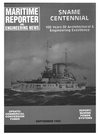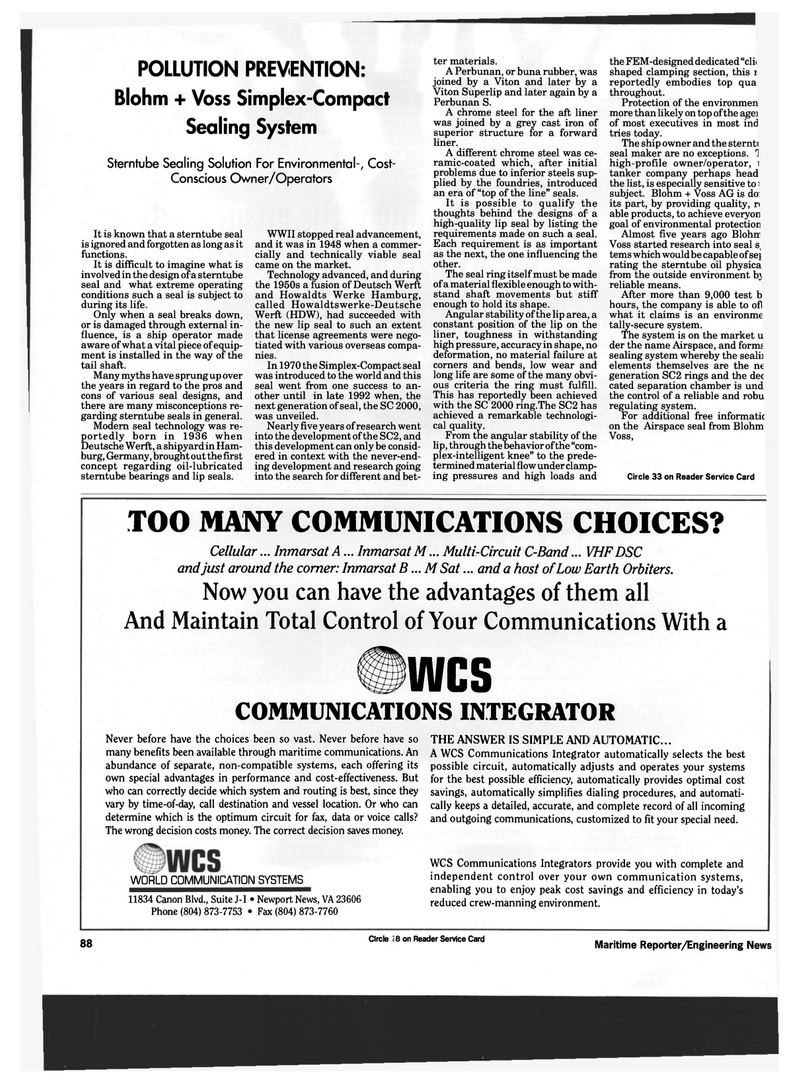
Page 94: of Maritime Reporter Magazine (September 1993)
Read this page in Pdf, Flash or Html5 edition of September 1993 Maritime Reporter Magazine
POLLUTION PREVENTION:
Blohm + Voss Simplex-Compact
Sealing System
Sterntube Sealing Solution For Environmental-, Cost-
Conscious Owner/Operators
It is known that a sterntube seal is ignored and forgotten as long as it functions.
It is difficult to imagine what is involved in the design of a sterntube seal and what extreme operating conditions such a seal is subject to during its life.
Only when a seal breaks down, or is damaged through external in- fluence, is a ship operator made aware of what a vital piece of equip- ment is installed in the way of the tail shaft.
Many myths have sprung up over the years in regard to the pros and cons of various seal designs, and there are many misconceptions re- garding sterntube seals in general.
Modern seal technology was re- portedly born in 1936 when
Deutsche Werft, a shipyard in Ham- burg, Germany, brought out the first concept regarding oil-lubricated sterntube bearings and lip seals.
WWII stopped real advancement, and it was in 1948 when a commer- cially and technically viable seal came on the market.
Technology advanced, and during the 1950s a fusion of Deutsch Werft and Howaldts Werke Hamburg, called Howaldtswerke-Deutsche
Werft (HDW), had succeeded with the new lip seal to such an extent that license agreements were nego- tiated with various overseas compa- nies.
In 1970 the Simplex-Compact seal was introduced to the world and this seal went from one success to an- other until in late 1992 when, the next generation of seal, the SC 2000, was unveiled.
Nearly five years of research went into the development of the SC2, and this development can only be consid- ered in context with the never-end- ing development and research going into the search for different and bet- ter materials.
A Perbunan, or buna rubber, was joined by a Viton and later by a
Viton Superlip and later again by a
Perbunan S.
A chrome steel for the aft liner was joined by a grey cast iron of superior structure for a forward liner.
A different chrome steel was ce- ramic-coated which, after initial problems due to inferior steels sup- plied by the foundries, introduced an era of "top of the line" seals.
It is possible to qualify the thoughts behind the designs of a high-quality lip seal by listing the requirements made on such a seal.
Each requirement is as important as the next, the one influencing the other.
The seal ring itself must be made of a material flexible enough to with- stand shaft movements but stiff enough to hold its shape.
Angular stability of the lip area, a constant position of the lip on the liner, toughness in withstanding high pressure, accuracy in shape, no deformation, no material failure at corners and bends, low wear and long life are some of the many obvi- ous criteria the ring must fulfill.
This has reportedly been achieved with the SC 2000 ring.The SC2 has achieved a remarkable technologi- cal quality.
From the angular stability of the lip, through the behavior of the "com- plex-intelligent knee" to the prede- termined material flow under clamp- ing pressures and high loads and the FEM-designed dedicated "clii shaped clamping section, this i reportedly embodies top qua throughout.
Protection of the environmen more than likely on top of the agei of most executives in most ind tries today.
The ship owner and the sternti seal maker are no exceptions. T high-profile owner/operator, 1 tanker company perhaps head the list, is especially sensitive to 1 subject. Blohm + Voss AG is do: its part, by providing quality, ri able products, to achieve everyon goal of environmental protection
Almost five years ago Blohn
Voss started research into seal s, tems which would be capable of sej rating the sterntube oil physica from the outside environment bj reliable means.
After more than 9,000 test b hours, the company is able to ofi what it claims is an environme tally-secure system.
The system is on the market u der the name Airspace, and forms sealing system whereby the sealii elements themselves are the n« generation SC2 rings and the dec cated separation chamber is und the control of a reliable and robu regulating system.
For additional free informatic on the Airspace seal from Blohm
Voss,
Circle 33 on Reader Service Card
TOO MANY COMMUNICATIONS CHOICES?
Cellular... Inmarsat A... Inmarsat M... Multi-Circuit C-Band... VHF DSC and just around the corner: Inmarsat B ...M Sat... and a host of Low Earth Orbiters.
Now you can have the advantages of them all
And Maintain Total Control of Your Communications With a
Owes
COMMUNICATIONS INTEGRATOR
Never before have the choices been so vast. Never before have so many benefits been available through maritime communications. An abundance of separate, non-compatible systems, each offering its own special advantages in performance and cost-effectiveness. But who can correctly decide which system and routing is best, since they vary by time-of-day, call destination and vessel location. Or who can determine which is the optimum circuit for fax, data or voice calls?
The wrong decision costs money. The correct decision saves money.
WORLD COMMUNICATION SYSTEMS 11834 Canon Blvd., Suite J-l • Newport News, VA 23606
Phone (804) 873-7753 • Fax (804) 873-7760
THE ANSWER IS SIMPLE AND AUTOMATIC...
A WCS Communications Integrator automatically selects the best possible circuit, automatically adjusts and operates your systems for the best possible efficiency, automatically provides optimal cost savings, automatically simplifies dialing procedures, and automati- cally keeps a detailed, accurate, and complete record of all incoming and outgoing communications, customized to fit your special need.
WCS Communications Integrators provide you with complete and independent control over your own communication systems, enabling you to enjoy peak cost savings and efficiency in today's reduced crew-manning environment. 88 Circle 318 on Reader Service Card Maritime Reporter/Engineering News

 93
93

 95
95
